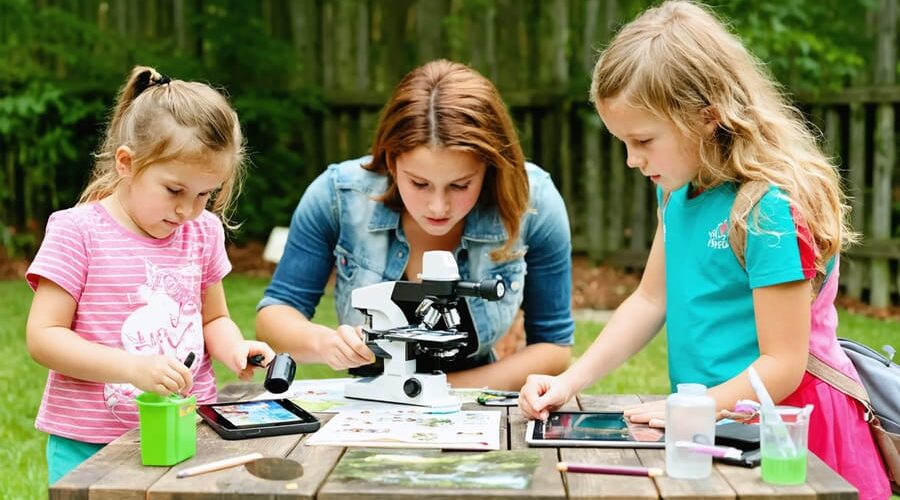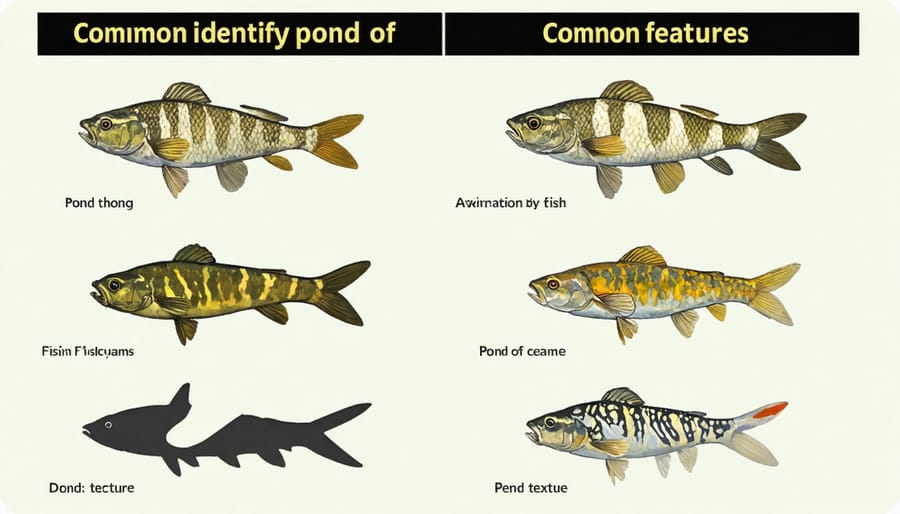
Make Fish and Wildlife Identification Fun: Hands-On Workshop Success Stories
Transform your backyard into a vibrant outdoor classroom by organizing hands-on fish and wildlife identification workshops. Start with basic species recognition skills, teaching participants to spot distinctive markings on local fish species, identify common bird calls, and recognize animal tracks along pond edges. Create interactive learning stations around your water feature, complete with field guides, magnifying glasses, and specimen collection containers for safe, temporary observation. Engage learners through practical exercises like mapping wildlife habitats, documenting seasonal changes, and photographing various species in their natural environments.
Set up your wildlife classroom strategically near natural gathering spots – beneath shade trees or beside calm waters where animals frequently visit. This hands-on approach builds lasting connections between participants and their local ecosystem while developing crucial observation skills. Whether you’re teaching children about tadpole development or helping adults identify native fish species, these dynamic outdoor sessions spark curiosity and foster environmental stewardship in ways no indoor classroom can match.
Setting Up Your Interactive Workshop Space
Essential Equipment and Materials
To create an engaging learning environment, you’ll need several essential items. Start with basic field guides specific to your local wildlife and fish species – these are invaluable references for both instructors and students. A collection of clear, laminated identification charts helps students learn visual recognition skills quickly.
For hands-on learning, gather magnifying glasses, binoculars for bird watching, and specimen collection nets. Digital cameras or smartphones are excellent for documenting observations, while notebooks and waterproof field journals help students record their findings. Consider including pH testing kits and water sampling equipment to understand habitat conditions.
Visual aids like wildlife flash cards, anatomical models, and life cycle diagrams make complex concepts easier to grasp. Don’t forget basic safety equipment: first aid kits, protective gloves, and appropriate footwear for field activities. A portable whiteboard or flip chart helps with impromptu explanations during outdoor sessions.
For tech-savvy learning, consider adding tablet devices loaded with wildlife identification apps and interactive field guides. These modern tools complement traditional methods and appeal to different learning styles.
Creating Hands-On Learning Stations
Set up distinct learning stations to make wildlife identification engaging and memorable. Create a feather identification table with samples from local waterfowl, along with magnifying glasses and field guides for detailed examination. Next to it, arrange a track casting station where students can study and make plaster casts of different animal footprints.
Establish an aquatic station with clear containers showing various fish species common to your area. Include identification cards highlighting key features like fin placement and coloring patterns. Set up a habitat matching game where participants connect different species to their preferred environments using cards or interactive boards.
Create a sounds station with audio recordings of local wildlife calls, complete with headphones and species pictures for reference. Include a microscope station for examining scales, fur samples, and other wildlife materials up close. Finally, set up a tech corner with tablets or computers loaded with wildlife ID apps and interactive resources.
Remember to rotate materials regularly and include both common and unique species to keep the learning experience fresh and challenging. Label everything clearly and provide simple worksheets to guide participants through each station.

Interactive Teaching Methods That Work
Digital Tools and Apps
Today’s fish and wildlife classes are enhanced by a variety of digital tools and apps that make learning more interactive and engaging. Start with iNaturalist, a fantastic community-based app that lets you photograph and identify species while contributing to citizen science projects. Another must-have is Merlin Bird ID, which helps identify birds through photos or by answering simple questions about what you’ve observed.
For underwater species identification, the Fish ID app offers detailed profiles and comparison tools that work great during pond and stream studies. Students can use these apps in real-time during field observations, making the learning process more dynamic and memorable.
Consider incorporating digital field notebooks like Nature Journal, where students can record observations, add photos, and track wildlife patterns over time. For weather tracking and understanding environmental conditions, Weather Underground provides detailed local data that’s crucial for wildlife behavior studies.
Many of these apps work offline, which is perfect for remote field locations. Encourage students to create shared digital galleries of their wildlife observations, fostering collaboration and discussion. Some apps even feature built-in quizzes and challenges that make learning fun and competitive.
Remember to balance screen time with direct observation – these tools should enhance, not replace, the hands-on experience of wildlife watching. Start with one or two apps initially, allowing students to become comfortable before introducing additional digital resources.

Group Activities and Games
Getting hands-on with wildlife identification becomes more engaging and memorable through interactive learning activities and group exercises. Here are some proven games that make species recognition fun and effective:
Nature Scavenger Hunt: Split participants into small teams and provide them with a checklist of local wildlife to find and photograph. Include both common and slightly challenging species to keep everyone engaged. Teams earn points for correct identifications and quality photos.
Wildlife Bingo: Create bingo cards featuring different species commonly found in your area. Instead of calling out numbers, show pictures or play animal sounds. Players must correctly identify the species to mark their cards.
Match and Learn: Print pairs of cards showing animals and their identifying features. Place them face down and let participants play a memory-style matching game while learning key characteristics.
Field Guide Race: Provide groups with field guides and show them various wildlife images. The first team to correctly identify the species and list three distinguishing features wins each round.
Species Charades: Have participants act out animal behaviors while others guess the species. This helps everyone remember distinctive movement patterns and habits that aid in identification.
These activities work best when rotated throughout a session, keeping energy levels high and reinforcing learning through different approaches. Remember to adapt the difficulty based on your group’s experience level and include local species they’re likely to encounter.
Common Species Recognition Tips
Fish Species Identification
When identifying fish in your pond, focus on distinct physical characteristics that make each species unique. Start by observing the fish’s overall body shape – is it long and slender like a koi, or deep-bodied like a goldfish? Pay attention to fin placement and shape, as these are crucial identifiers in aquatic ecosystems.
Color patterns provide another valuable clue. Goldfish typically display solid orange, red, or white coloring, while koi showcase intricate patterns with multiple colors. Look for specific markings like spots, stripes, or patches that are characteristic of certain species. The fish’s mouth position and shape can also reveal its identity – bottom-feeders have downward-facing mouths, while surface feeders’ mouths point upward.
Size is another helpful indicator, but remember that young fish may not have reached their full adult size. Watch their behavior too – some species prefer staying near the bottom, while others are active swimmers in the middle or upper water levels.
For accurate identification, observe the fish during different times of day and in various weather conditions, as their appearance and behavior might change. Take photos if possible, as this helps track any changes in their appearance over time.

Wildlife Around Your Pond
Your backyard pond is more than just a water feature – it’s a thriving ecosystem that attracts fascinating wildlife. Regular visitors typically include various bird species, from majestic herons to cheerful songbirds that stop by for a drink or bath. You might spot mallards paddling across the surface or kingfishers perched nearby, watching for small fish.
Amphibians are particularly common pond residents. Listen for the distinctive calls of frogs in the evening, and watch for toads hopping around the pond edges. In spring, you may notice frogspawn or toad eggs in the shallows, followed by tadpoles as the season progresses.
Keep an eye out for dragonflies and damselflies darting above the water – these skilled aerial hunters add vibrant colors to your pond scene. Beneficial insects like water striders and diving beetles help maintain the pond’s natural balance.
You might also encounter welcome visitors like turtles basking on rocks or raccoons stopping by for a drink. Even deer may visit during quiet moments. To better identify your pond’s wildlife, consider keeping a journal of your observations and taking photos when possible. The more you watch, the more you’ll discover about your pond’s unique ecosystem.
Safety and Ethical Considerations
When studying fish and wildlife, it’s crucial to prioritize both your safety and the well-being of the animals you’re observing. Always maintain a respectful distance from wildlife to avoid causing stress or disrupting their natural behaviors. Never attempt to handle wild animals without proper training and permits, as this can be dangerous for both you and the creature.
If your class involves water activities, ensure everyone wears appropriate safety gear, including life jackets when near deep water. Have a first aid kit readily available and establish clear emergency procedures before starting any outdoor sessions. Work in pairs or small groups rather than alone, especially when conducting field observations.
When photographing wildlife, use zoom lenses instead of getting too close, and never bait or lure animals for better shots. If you’re studying in wetland areas, wear appropriate footwear and be aware of potentially slippery surfaces. Protect yourself from sun exposure and insects by wearing suitable clothing and using appropriate protection.
Remember that many species are protected by law, so familiarize yourself with local regulations regarding wildlife interaction. Keep detailed records of your observations without disturbing natural habitats. If you encounter injured wildlife, contact local wildlife authorities rather than attempting to help the animal yourself.
Clean and sanitize any equipment used between sessions to prevent the spread of diseases among wildlife populations. This not only protects the animals but also ensures accurate data collection for your studies.
Interactive workshops bring wildlife education to life, making learning both enjoyable and memorable. By incorporating hands-on activities, real specimens, and engaging group discussions, participants develop a deeper understanding and appreciation for local fish and wildlife. These workshops create lasting connections between people and nature, inspiring continued learning and conservation efforts. Whether you’re teaching children or adults, the practical skills gained through these sessions empower participants to become better stewards of their environment. Consider implementing these workshop methods in your own educational programs – you’ll be amazed at how quickly students become passionate about wildlife identification and habitat conservation. Start small, be creative with your resources, and remember that every interactive lesson plants a seed for future environmental awareness and appreciation.
